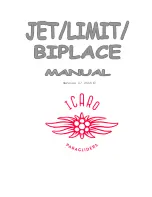
MAINTENANCE MANUAL
SAVANNAH S
Doc. No.:
MM-SVNH-EN
Revision:
07
Rev. Date:
07/11/2022
Proj. Ref.:
SVNH S
A/C:
Savannah S
Applies to Generic Serial Number:
yy-mm-54-xxxx
Page:
28/132
DOC
FMM00
1.19.1. Engine lifting
The engine can be lifted up from the intake aluminium manifold pipes, where is present a dedicated
ring. Always refer to the approved engine manufacturer manuals to execute operations on
powerplant.
1.20. Aircraft Levelling
The aircraft is levelled when the fuselage cone upper skin, just behind the wing rear attachments, is
set horizontal, both longitudinally and transversally.
1.21. Aircraft weighing
The aircraft can be weighed by lifting on a multiple points described in the
Chapter 1.19
from the three wheels, with scales.
When needed to calculate the aircraft Weight and Center of Gravity, apply the following procedure:
-
Level the aircraft (ref.
Chapter 1.20
-
Zeroing of the scales;
-
Place the aircraft on three scales, one for each wheel;
-
Take note of the weights indicated by the scales;
-
Apply the calibration delta to the values, if present a calibration table of the scales;
-
Vertically project with a plumb line the wing leading edge position on the floor, then measure
from this point the distance of the nose gear DF and the distance of the main landing gear
DR;
-
Alternatively, apply design values of these Distances, only if the airplane has been correctly
levelled according to
Chapter 1.20
: DF=0.825 [m], DR=0.691 [m]. For tail dragger aircraft
configuration the tail is DF=-4.373 [m] and main wheels are DR=0.163 [m].
-
Use the following formula to calculate the resulting weight and longitudinal center of gravity:
𝑊
𝑇𝑂𝑇
= 𝑊
𝐹
+ 𝑊
𝑅 𝑅𝑋
+ 𝑊
𝑅 𝐿𝑋
[𝑘𝑔]
𝑋
𝐶𝐺
=
(𝑊
𝑅 𝑅𝑋
+ 𝑊
𝑅 𝐿𝑋
) ∙ 𝐷
𝑅
− 𝑊
𝐹
∙ 𝐷
𝐹
𝑊
𝐹
+ 𝑊
𝑅 𝑅𝑋
+ 𝑊
𝑅 𝐿𝑋
[𝑚]
𝑋
𝐶𝐺
(% 𝑀𝐴𝐶) =
𝑋
𝐶𝐺
∙ 100
𝑀𝐴𝐶
=
𝑋
𝐶𝐺
∙ 100
1.32











































